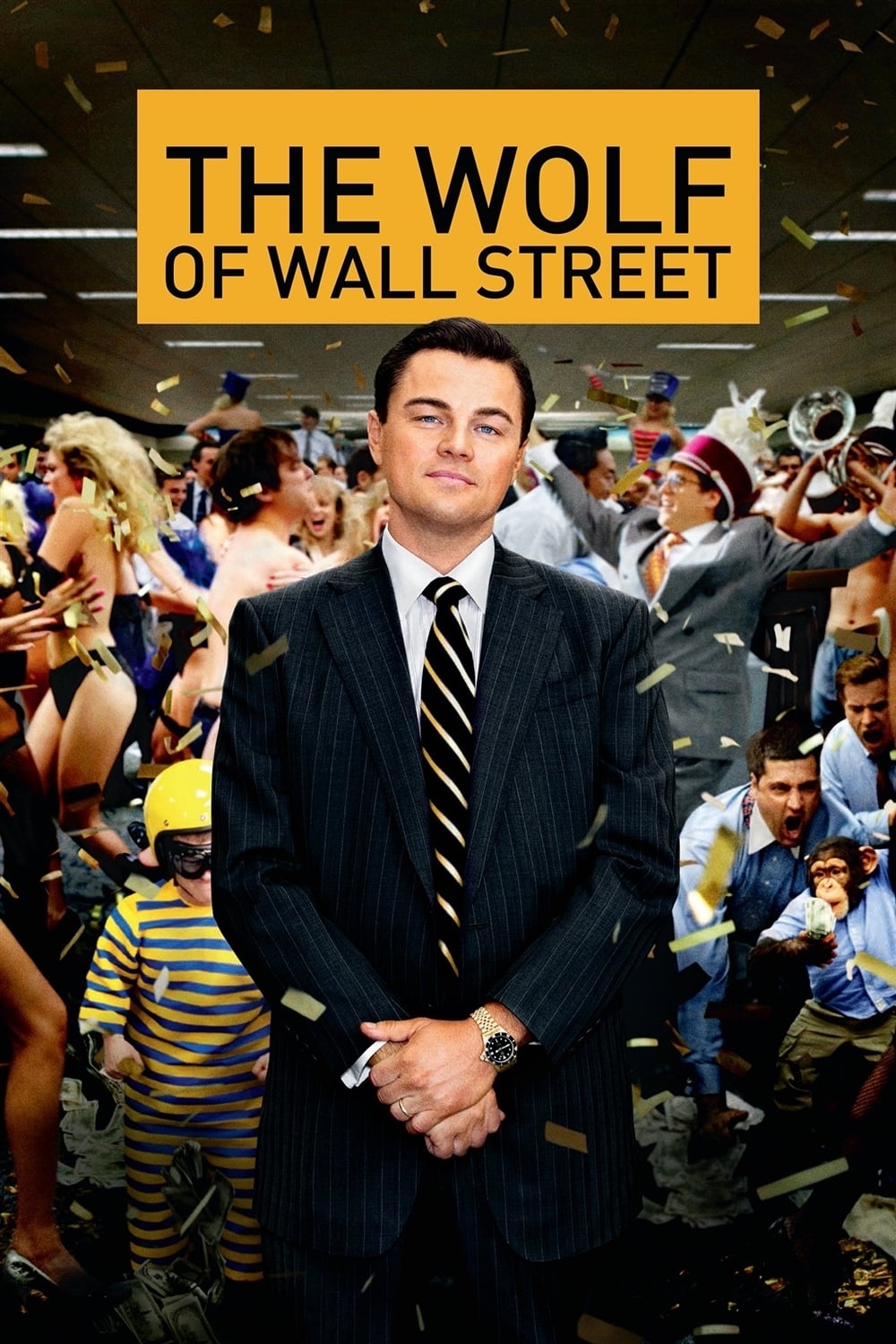Spoilers:
- Jordan rats on his friends.
- He cheats on his wives.
- The yacht sinks dramatically.
- He’s addicted to drugs.
- Makes tons of illegal money.
- FBI finally arrests him.
- He’s banned from stock trading.
- The pen sales speech at end.
The Wolf of Wall Street Statistics
General Information
- Title: The Wolf of Wall Street
- Release Year: 2013
- Director: Martin Scorsese
- Screenplay: Terence Winter
- Based on: Memoir by Jordan Belfort
- Running Time: 180 minutes
- Genre: Biographical, Comedy, Crime
Box Office
- Budget: $100 million
- Opening Weekend USA: $18.4 million
- Gross USA: $116.9 million
- Worldwide Gross: $392 million
Main Cast
- Leonardo DiCaprio as Jordan Belfort
- Jonah Hill as Donnie Azoff
- Margot Robbie as Naomi Lapaglia
- Matthew McConaughey as Mark Hanna
- Kyle Chandler as Patrick Denham
Accolades
- 5 Oscar Nominations
- Winner of Best Actor – Musical or Comedy (Golden Globes)
Critical Reception
- Rotten Tomatoes Score: 79%
- Metacritic Score: 75/100
- IMDb Rating: 8.2/10
Martin Scorsese’s “The Wolf of Wall Street” is an incisive reflection of the human id unleashed, a dizzying commentary on the capitalist excesses and the implications of unabated greed. Built around the larger-than-life character of Jordan Belfort, a stockbroker who manipulated Wall Street for his selfish pursuits, the film is an uncomfortable mirror showcasing the opulent decadence of the 1990s financial world.The film’s brilliance lies not only in its audacity but also in its multi-layered approach. On one hand, it is a perverse celebration of hedonism and on the other, it provokes thought about the moral abyss underneath the glitz. Amidst a bewildering cyclone of drugs, sex, and money, Belfort remains human – flawed, tragic, unrepentant, elevating the narrative beyond a mere fall-from-grace tale.Scorsese’s virtuoso and the provoking screenplay plunge the viewer into the repulsively charismatic Belfort’s world. His life is an unending party, an overindulgence, which the audience is compelled to partake in and detest simultaneously. The protagonist’s frenzied journey is further amplified by Leonardo DiCaprio’s hard-hitting performance, reflecting a pathos that arrests and hangs over viewers.“Wolf of Wall Street” explores how unchecked capitalism encourages the commodification of everything including human lives and values. It aggressively questions the essence of the ‘American Dream’ and unsparingly deciphers its basest form – an uncontrollable desire for wealth and power.The film is neither a condemnation nor a glorification of Belfort. It squarely places the facts, wrapped in layers of dark humor, leaving viewers with a sense of unease, compelling them to reflect on their collective ethos within the current socio-economic context.In its essence, “The Wolf of Wall Street” encapsulates the dangers inherent in greed-filled pursuit of power and wealth. It stands as an enlightening, if disconcerting, exploration of the human spirit in its darkest realms, offering a profound, resounding narrative that lingers in collective consciousness long after the ride has screeched to its inevitable halt.
The Wolf of Wall Street: An Introduction
“The Wolf of Wall Street” is a film that explores the dizzying rise and catastrophic fall of stockbroker Jordan Belfort. Directed by Martin Scorsese, the film debuted in 2013 and quickly became a cultural phenomenon, known for its unapologetic portrayal of Belfort’s lavish lifestyle, moral depravity, and financial crime spree.
Interesting Facts
- Based on a true story, the film is adapted from Jordan Belfort’s memoir, detailing his time at brokerage firm Stratton Oakmont.
- Leonardo DiCaprio, who plays Belfort, spent extensive time with the real Belfort to prepare for the role.
- The film set a record for the most instances of the f-word in a mainstream, scripted film with over 500 uses.
Speculation and Controversy
There are several controversies surrounding “The Wolf of Wall Street.” Chief among them is the film’s perceived glamorization of unethical behavior and fraud. Critics argue the storytelling often blurs the line between critique and glorification.
Interestingly, speculation exists regarding the funding of the film itself, linked to an international embezzlement scandal known as the 1MDB scandal.
Bizarre and Interesting Elements
- The movie features outrageous scenes including dwarf-tossing and quaalude-induced mishaps.
- Matthew McConaughey’s chest-thumping chant was an improvised moment that made the final cut and became iconic.
Public Perception Over Time
Upon release, “The Wolf of Wall Street” divided audiences and critics alike. Some praised its bold storytelling and performances, especially DiCaprio’s, who received an Oscar nomination. Others criticized its excess and lack of moral consequence.
Over time, it has maintained a dual perception—as both an entertaining showcase of excess and a cautionary tale about the perils of greed. The film has steadily grown a cult following, often quoted and referenced in popular culture.
Regardless of opinion, “The Wolf of Wall Street” endures as a significant piece of cinema, continuing to spark debates on ethics, excess, and filmmaking.
The Wolf of Wall Street: A Rapid-Fire Beat Breakdown
Wolf’s Howl: Jordan Belfort lands at Wall Street, hungry and ready to sink his teeth in.
The First Kill: Black Monday bites, but Belfort’s hunger only grows. He sniffs out penny stocks and plots his comeback.
Pack Formation: Gathering a motley crew of drug-fueled, sales-savvy wolves, Stratton Oakmont is born – a den of excess and ambition.
The Hunt: They sell hard, party harder. Money flows like champagne – which is also flowing. Excess is the new normal.
Alpha’s Rise: Jordan’s empire booms. He’s the Alpha, but unlike any before. He’s richer, wilder, more cunning.
- Drug-fueled weekdays
- Money laundering luncheons
- Securities fraud soirées
Feeding Frenzy: Jordan’s lifestyle spirals. More money, more problems. Drugs, yachts, and Swiss banks – the holy trinity of downfall.
Wolf in Sheep’s Clothing: At the height of hubris, Jordan tries to appear legit. It fools no one, least of all the feds. The hunt turns inward.
Cornered Beast: FBI on his tail, Jordan’s empire crumbles. Loyalties wane. The pack starts to disperse, scenting the blood in the water.
The Downfall: Reality claws back. Jordan is indicted, his pride wounded, his pack scattered. The dream of invincibility, shattered.
Lone Wolf: House arrest isn’t the den he’s used to. The hustle is gone. He’s no longer the predator he was – just another storyteller, selling his story.
Final Howl: Jordan, ever the salesman, turns his wolfish saga into a lesson. “Sell me this pen.” The Alpha’s legacy is not in what he hunted, but in the hunt itself.

The Wolf of Wall Street: An Analytical Breakdown
Story Opening
The story opens with high energy. Jordan Belfort, the protagonist, introduces himself in a fast-paced, engaging manner. The use of voiceover narration pulls the audience into his world instantly. It’s loud, chaotic, and sets the tone for the wild ride ahead. The opening scene juxtaposes opulence against the backdrop of moral ambiguity. It instantly captivates, prepping viewers for the rollercoaster of excess and greed that defines the film.
Story Formula Breakdown
- Exposition: Introduces Jordan Belfort as a stockbroker. The audience sees his rise and the lure of Wall Street’s promises.
- Inciting Incident: Jordan’s introduction to penny stocks. This small, risky territory leads him into the big leagues.
- Rising Action: Rapid success follows, showcasing wild parties, drugs, and extravagant lifestyles. The brokerage firm he establishes grows rapidly.
- Climax: The law begins to close in. Jordan’s unchecked extravagance leads to conflict with the FBI.
- Falling Action: The cracks in his life start to show. Relationships crumble, and desperation sets in.
- Resolution: Jordan’s ultimate downfall and subsequent cooperation with the authorities. He faces the consequences of his actions.
Character vs. Story Driven
This story is more character-driven. Jordan Belfort’s narrative is the heartbeat of the film. The audience follows his motivations, desires, and flaws throughout. The overarching plot serves primarily as a backdrop for showcasing Jordan’s development—and eventual decline—rather than being the central focus itself.
Memorable Character Traits
Jordan is memorable due to his sheer charisma and ambition. He embodies the excesses of the financial world. His moral decline resonates. The blend of charm, arrogance, and an insatiable appetite for wealth creates a complicated character that audiences can’t easily forget. He’s the anti-hero who’s both captivating and repulsive.
Main Characters
- Jordan Belfort: A charismatic stockbroker whose journey from rags to riches highlights the excesses and pitfalls of greed.
- Donnie Azoff: Jordan’s loyal partner in crime. His outrageous personality matches Jordan’s ambition.
- Naomi Lapaglia: Jordan’s second wife. She represents both his desires and the consequences of his lifestyle.
- Mark Hanna: Jordan’s mentor on Wall Street. His role emphasizes the culture of excess in the financial industry.
- Agent Patrick Denham: The relentless FBI agent who symbolizes the law catching up with Jordan and his cronies.
Story Flow Template
- Introduction: Introduce the protagonist in their initial setting. Showcase their desires and dreams.
- Setting Trigger: A moment or event that propels the protagonist into a new world.
- Exploration of New World: Show the protagonist’s rise, detailing their actions and reactions. Include supporting characters that either assist or hinder them.
- Escalating Conflict: Introduce challenges, both internal and external. Bring tension to relationships and highlight the protagonist’s moral decline.
- Climactic Turning Point: The point where consequences become unavoidable. The protagonist faces their ultimate challenge.
- Aftermath: Explore the fallout after the climax. How do the events change the protagonist or their relationships?
- Resolution: Offer a final moment that reflects on the story’s themes. What does the protagonist learn, if anything, by the end?
Simple Story Summary
The Wolf of Wall Street is about the rise and fall of Jordan Belfort, a wealthy stockbroker whose hedonistic lifestyle leads to corruption and law enforcement’s pursuit. It’s a cautionary tale about excess and the moral decay that can come from chasing wealth and status without regard for ethics.
Deep Dive: Themes & Implications
The film is not just a biopic; it touches on deeper themes like the American Dream, greed, and moral ambiguity in business practices. Belfort’s journey presents a window into the culture of Wall Street in the late 20th century. It’s not just about financial gain, but the lengths people go to achieve it. The moral questions linger long after the credits roll.
Visual Style
The cinematography and editing style are frenetic. Quick cuts, vibrant colors, and a raw energy encapsulate the chaos of Belfort’s life. It mirrors the highs and lows of stock trading and captures the essence of a lifestyle filled with both euphoria and despair.
Popularity and Cultural Impact
The Wolf of Wall Street resonated with audiences due to its entertaining yet critical portrayal of the financial industry’s excesses. It sparked discussions about ethics, regulation, and moral behavior in business, making it more than just a film—it became a cultural reference point.
Box Office and Acclaim
The film achieved significant box office success, grossing over $392 million worldwide. It was nominated for several Academy Awards, highlighting its merit beyond just commercial success. Critics praised it for its direction and performances, particularly Leonardo DiCaprio’s compelling portrayal of Belfort.
Conclusion of Character Analysis
The film’s characters are larger than life, reflecting the excesses they embody. Jordan Belfort, as the main character, serves as both a hero and a villain—his journey is a relentless pursuit of happiness through wealth, leading to self-destruction.
Real-Life Representation
While heavily dramatized, the film draws from Belfort’s memoir, offering glimpses into the real-life events that transpired. This authenticity adds weight to its narrative. The financial crisis may be behind us now, but the themes presented remain relevant.
A Message to Aspiring Writers
The Wolf of Wall Street teaches the importance of character. Audiences connect with flawed but fascinating individuals. In your writing, prioritize character development. Let their flaws, desires, and conflicts drive the narrative forward.
The film is a lesson in storytelling. Even amidst chaos and rapid growth, character arcs remain central. Give your characters depth. Let them struggle, grow, and face consequences. That’s what keeps readers or viewers engaged.
Inciting Incident
The inciting incident in “The Wolf of Wall Street” is Jordan Belfort losing his job on Wall Street after Black Monday. This event pushes him into the world of penny stocks. It symbolizes the beginning of his moral decline and his shift from a conventional career to one driven by greed and excess.
Act Structure
The movie follows a three-act structure:
-
Act 1: Setup
Jordan starts at a reputable firm, learns about the stock market, and gets fired. This act establishes his character as ambitious but naïve. The portrayal of Wall Street culture introduces viewers to the financial world’s allure and pitfalls.
-
Act 2: Confrontation
Jordan forms his own brokerage, Stratton Oakmont. He employs unorthodox methods to sell penny stocks. Here, tensions rise as wealth accumulates, and corruption becomes evident. The audience sees moral ambiguity and the costs of his success—both personal and professional. The famous scene of the yacht party is a highlight, representing unrestrained hedonism.
-
Act 3: Resolution
The law closes in on Jordan and his associates. Betrayals surface, leading to his downfall. This act shows the consequences of unchecked ambition and greed. The rise-and-fall narrative resonates strongly, serving as a cautionary tale.
Climax
The climax occurs when Jordan’s empire crumbles during the FBI raid. Emotional capital is high here—viewers feel the weight of his choices culminating in chaos. The tension builds as he becomes increasingly paranoid, realizing his web of lies is unraveling. It’s a significant turning point, showcasing a full-circle moment of his moral corruption.
Tension and Release
The film builds tension through high-stakes situations and escalating consequences of Jordan’s lifestyle. Fast-paced editing and intense music create urgency. Quick cuts from parties to confessions convey the chaos of his life.
Release comes in the form of dark humor and shocking moments that break the tension, then quickly pull viewers back into the adrenaline rush. Each high is followed by a low, allowing audience members to breathe briefly before diving back into the turmoil.

Ending of The Wolf of Wall Street Explained
The ending shows Jordan Belfort, played by Leonardo DiCaprio, facing the consequences of his actions. After getting caught by the FBI, he’s sentenced to prison. However, when he gets out, he’s still charismatic and slick. He starts a new career in motivational speaking, still luring people in with his charm.
How Writers Would Categorize the Ending
The ending can be categorized as ironic and cautionary. It highlights the cycle of greed and excess while showcasing the unrepentant nature of the protagonist.
Symbolic, Thematic, and Speculative Meanings
- Symbolism: The ending symbolizes the endless cycle of corruption in Wall Street and society’s blind spot towards it.
- Themes: Major themes include greed, ambition, and the idea of redemption—though not genuinely achieved.
- Speculative: It raises questions about whether real change is possible for someone so entrenched in dishonest ways.
Loose Ends and Payoffs Resolved
The ending wraps up Belfort’s character arc, showing how he never truly learns from his mistakes. We see how society enables his behavior, leaving viewers with a sense of unresolved issues in moral accountability.
Character Changes by the End
Jordan does not really change; he’s still the same narcissistic person. The other characters, like his wife and associates, either suffer or align with his morally questionable lifestyle, showing the toxic environment they all thrived in.
Lessons for Writers
Writers can learn that complex characters can both fascinate and repulse. A flawed protagonist can maintain interest without achieving redemption. Furthermore, leaving some questions unanswered can enhance thematic depth and provoke reflection.
Dialogue Style in The Wolf of Wall Street
The dialogue in The Wolf of Wall Street is fast-paced, energetic, and filled with slang. It reflects the outrageous and hyperbolic world of finance, encapsulating a culture driven by greed and excess.
Example Dialogue
One of the iconic moments is when Jordan Belfort, played by Leonardo DiCaprio, famously declares: “I’m not going to die sober!” This line captures his reckless attitude and life philosophy.
Quintessential Character Moment
Another quintessential moment is when he motivates his team with the line: “The year I turned 26, I made 49 million dollars, which was a record for my firm.” This encapsulates his ambition and the destructive nature of his success.
Iconic Lines
- “Sell me this pen.”
- “There’s no nobility in poverty.”
- “We’re not here to make friends.”
Uniqueness of Dialogue
The dialogue is unique due to its rawness. There’s little filter; characters speak their minds with unapologetic clarity. The use of profanity and jargon creates an authentic, immersive experience in the world of Wall Street.
Dialogue Density
The script is dialogue-heavy, with fast exchanges mirroring the chaotic lifestyle of the characters. Conversations flow rapidly, almost overlapping, adding to the tension and excitement.
Realism of Dialogue
The dialogue is quite realistic, especially in how it portrays the aggressive, competitive, and often surreal nature of the finance world. The characters speak as people in that environment likely would, albeit heightened for entertainment.
Writer Takeaways
Writers can learn the importance of rhythm in dialogue. Quick exchanges can maintain momentum and reflect character dynamics effectively. Authenticity in voice matters; characters should speak true to their environment.
Scene Walkthrough
In the scene where Jordan leads his team during a sales meeting, the energy is palpable. With lines such as: “The term ‘quintessential’ means you’re doing something right!”, Jordan excites his brokers. The dialogue shifts from sales pitches to motivational speeches, interspersed with humor. The rapid-fire delivery captures their adrenaline-fueled urgency.
This dialogue-heavy interaction reveals Jordan’s charisma and manipulative skills. His ability to inspire enthusiasm, despite the ethical gray areas, is palpable. Each line builds upon the other, creating a crescendo of energy that is both captivating and unsettling.
The Wolf of Wall Street
A hustler’s dance on a ledge,
Where greed wears a smile,
And the ticker tape murmurs,
Counting dreams in fractions of seconds.
Wine flows like stories,
Each sip a plotted scheme,
Beneath the glint of ambition, they chase shadows,
Men in suits, wolves in hearts,
- Risks taken with a wink
- Fortunes built on whispers
- Allies or enemies, a fine line
Chasing numbers,
losing sight of the soul.
When the bubbles burst,
The echoes are louder,
Than the laughter in the halls.
A banquet of excess,
With the knife edge of reality,
Cutting through the feast.
Yet, in this vertigo,
We find the rhythm,
Of all that is fickle.
Unique Writing Lessons from The Wolf of Wall Street
Scorsese’s film isn’t just about the excesses of Wall Street. It’s a masterclass in narrative style and character development. Here are some unique insights:
-
Unreliable Narrator
The main character, Jordan Belfort, narrates his own story. This creates a tension between viewer perception and protagonist reliability. It challenges audiences to decipher truth from self-serving lies.
-
Pacing and Rhythm
Scenes are edited for quick cuts and high energy. This mirrors the chaotic lifestyle of the characters and maintains viewer engagement. It’s a reminder that pacing can elevate the story’s emotional stakes.
-
Conversational Dialogue
Dialogue is raw and often laced with humor. It reflects the characters’ personalities and the culture of the environment. Authenticity in dialogue makes characters relatable despite their flaws.
-
Show, Don’t Tell
Much of the story is conveyed through visuals and actions, not exposition. The lavish parties, the fast cars, and the antics reveal character deeper than words ever could.
-
Conflict Through Ambition
Belfort’s desire for power drives the narrative. The internal and external conflicts stemming from this ambition highlight character flaws and lead to inevitable downfall. Use ambition as a double-edged sword in storytelling.
-
Juxtaposition of Humor and Horror
Dark humor frames serious consequences in a lighter tone. This juxtaposition keeps viewers engaged while making them reflect on the underlying morality of the characters’ actions.
-
Character Arcs
Characters are dynamic and flawed. Their arcs are not just about growth, but also about the cost of their choices. Generating empathy amidst moral ambiguity can make for compelling storytelling.
-
Visual Symbolism
Recurring visual motifs (like the yacht) symbolize wealth and excess, contributing to the narrative. Incorporate symbols to deepen story themes and character journeys.
-
Ambiguous Morality
The film blurs lines between right and wrong. It invites audiences to grapple with their own morals when engaging with antagonistic characters. Don’t shy away from complexity in themes.
Martin Scorsese: A Brief Discography
Martin Scorsese is widely regarded as one of the greatest directors in film history. Known for his intense and dynamic storytelling, he has a significant number of acclaimed films to his name.
- Mean Streets (1973) – A gritty portrayal of life in the streets of New York.
- Taxi Driver (1976) – A psychological exploration of loneliness and rage.
- Raging Bull (1980) – A biographical sports drama about boxer Jake LaMotta.
- The Goodfellas (1990) – A stylish and brutal look at organized crime.
- Casino (1995) – A detailed examination of the Las Vegas gambling industry.
- The Departed (2006) – A tense crime thriller that won him an Academy Award for Best Director.
- The Wolf of Wall Street (2013) – A satirical look at the excesses of Wall Street.
- Silence (2016) – A spiritual journey set in 17th-century Japan.
- The Irishman (2019) – A reflective crime saga spanning decades.
Scorsese’s style blends raw emotion with intricate character studies, often depicting themes of morality, violence, and redemption.
Review 1:”The Wolf of Wall Street may be Scorsese’s most fully realized movie, with its elaboration of a world view that, taken on its own terms, makes perfect sense…For three hours you’re hooked on every rapid-fire, raucous word of it.” – Richard Corliss, Time MagazineRead Full Review here: http://entertainment.time.com/2013/12/17/review-million-dollar-baby-scorseses-wolf-of-wall-street/Review 2:”The Wolf of Wall Street is one of the most outrageous, shocking and provocative films in years… Even though it is exaggerated and larger than life, Scorsese and screenwriter Terence Winter are able to make it a reflection of the range of human nature.” – Cameron Williams, The Popcorn Junkie Read Full Review here: https://www.thepopcornjunkie.com/post/reviewthewolfofwallstreetReview 3:”Directed with ferocious, infectious energy by Martin Scorsese, and brimming over with exhilarating, adrenaline-rush humor, ‘Wolf’ is a stunning indictment not only the criminal culture of Wall Street, but also of the wild party culture America….” – John Serba, mlive.comRead Full Review here: https://www.mlive.com/entertainment/2013/12/movie_review_the_wolf_of_wall.htmlReview 4:”The Wolf of Wall Street finds Martin Scorsese and Leonardo DiCaprio at their most infectiously dynamic. It’s a raw, riotous, and rambunctious movie that tosses subtlety to the wind and embraces excess at every level.” – James Berardinelli, Reel ViewsRead Full Review here: http://www.reelviews.net/reelviews/wolf-of-wall-street-theReview 5:”This is Scorsese’s funniest and most focused film in a long time, a jet-black sex and drug-soaked comedy of out-of-control self-indulgence, laced with a stinging critique of white male privilege run amok.” – Tim Robey, The TelegraphRead Full Review here: https://www.telegraph.co.uk/culture/film/filmreviews/10532128/The-Wolf-of-Wall-Street-review.html
- The Wolf of Wall Street (2013 film) – Wikipedia
- Martin Scorsese Defends ‘The Wolf of Wall Street’: ‘The Devil Comes …
- In order to work with Martin Scorsese for The Wolf of Wall Street …
- The Wolf of Wall Street (2013) – IMDb
- TIL Martin Scorsese made a cameo in The Wolf of Wall Street. He is …
- Martin Scorsese’s “The Wolf of Wall Street” | The New Yorker
- Martin Scorsese – Agent Patrick Denham. THE WOLF OF WALL …
- THE MASTER NAMED MARTIN SCORSESE – The Wolf of Wall …
- The Wolf of Wall Street (Martin Scorsese, 2013) – criterionforum.org
- Martin Scorsese and The American Dream




Leave a Reply